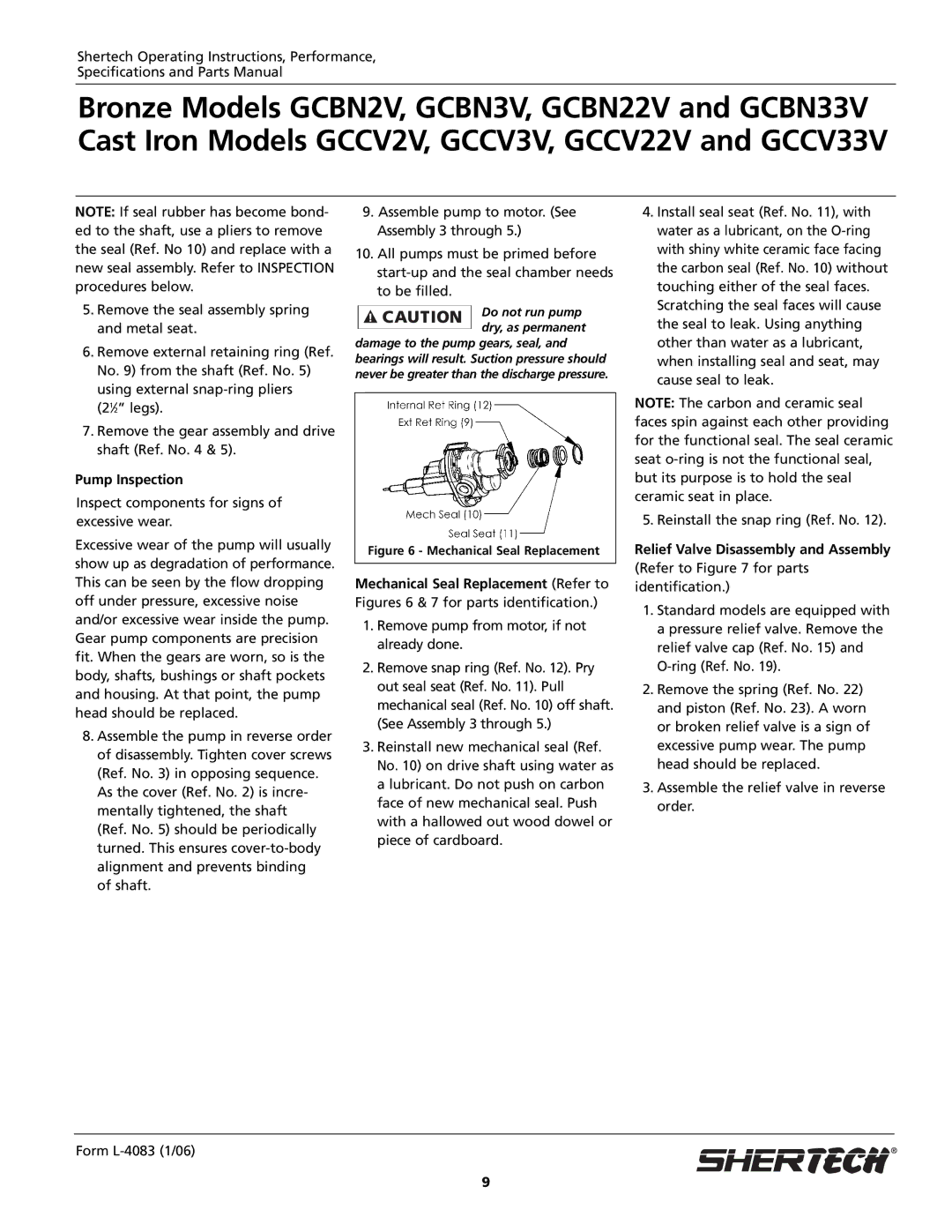
Shertech Operating Instructions, Performance,
Specifications and Parts Manual
Bronze Models GCBN2V, GCBN3V, GCBN22V and GCBN33V Cast Iron Models GCCV2V, GCCV3V, GCCV22V and GCCV33V
NOTE: If seal rubber has become bond- ed to the shaft, use a pliers to remove the seal (Ref. No 10) and replace with a new seal assembly. Refer to INSPECTION procedures below.
5.Remove the seal assembly spring and metal seat.
6.Remove external retaining ring (Ref. No. 9) from the shaft (Ref. No. 5) using external
7.Remove the gear assembly and drive shaft (Ref. No. 4 & 5).
Pump Inspection
Inspect components for signs of excessive wear.
Excessive wear of the pump will usually show up as degradation of performance. This can be seen by the flow dropping off under pressure, excessive noise and/or excessive wear inside the pump. Gear pump components are precision fit. When the gears are worn, so is the body, shafts, bushings or shaft pockets and housing. At that point, the pump head should be replaced.
8.Assemble the pump in reverse order of disassembly. Tighten cover screws (Ref. No. 3) in opposing sequence.
As the cover (Ref. No. 2) is incre- mentally tightened, the shaft (Ref. No. 5) should be periodically turned. This ensures
9.Assemble pump to motor. (See Assembly 3 through 5.)
10.All pumps must be primed before
Do not run pump dry, as permanent
damage to the pump gears, seal, and bearings will result. Suction pressure should never be greater than the discharge pressure.
Figure 6 - Mechanical Seal Replacement
Mechanical Seal Replacement (Refer to Figures 6 & 7 for parts identification.)
1.Remove pump from motor, if not already done.
2.Remove snap ring (Ref. No. 12). Pry out seal seat (Ref. No. 11). Pull mechanical seal (Ref. No. 10) off shaft. (See Assembly 3 through 5.)
3.Reinstall new mechanical seal (Ref. No. 10) on drive shaft using water as a lubricant. Do not push on carbon face of new mechanical seal. Push with a hallowed out wood dowel or piece of cardboard.
4.Install seal seat (Ref. No. 11), with water as a lubricant, on the
NOTE: The carbon and ceramic seal faces spin against each other providing for the functional seal. The seal ceramic seat
5. Reinstall the snap ring (Ref. No. 12).
Relief Valve Disassembly and Assembly
(Refer to Figure 7 for parts identification.)
1.Standard models are equipped with a pressure relief valve. Remove the relief valve cap (Ref. No. 15) and
2.Remove the spring (Ref. No. 22) and piston (Ref. No. 23). A worn or broken relief valve is a sign of excessive pump wear. The pump head should be replaced.
3.Assemble the relief valve in reverse order.
Form L-4083 (1/06)
9
